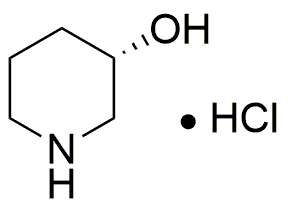(S)-3-Hydroxypiperidine hydrochloride is widely utilized in research focused on
- Pharmaceutical Development: This compound serves as a key intermediate in the synthesis of various pharmaceuticals, particularly in the development of drugs targeting neurological disorders.
- Chemical Synthesis: It is frequently used in organic synthesis as a building block for creating more complex molecules, allowing chemists to streamline their processes.
- Research in Neuroscience: The compound is valuable in neuroscience research for studying neurotransmitter systems and developing potential treatments for conditions like depression and anxiety.
- Biochemical Applications: Its properties make it suitable for use in biochemical assays, helping researchers understand enzyme activities and interactions in biological systems.
- Material Science: It can be incorporated into polymer formulations, enhancing the properties of materials used in various applications, including coatings and adhesives.
Informations générales
Propriétés
Sécurité et réglementation
Applications
(S)-3-Hydroxypiperidine hydrochloride is widely utilized in research focused on
- Pharmaceutical Development: This compound serves as a key intermediate in the synthesis of various pharmaceuticals, particularly in the development of drugs targeting neurological disorders.
- Chemical Synthesis: It is frequently used in organic synthesis as a building block for creating more complex molecules, allowing chemists to streamline their processes.
- Research in Neuroscience: The compound is valuable in neuroscience research for studying neurotransmitter systems and developing potential treatments for conditions like depression and anxiety.
- Biochemical Applications: Its properties make it suitable for use in biochemical assays, helping researchers understand enzyme activities and interactions in biological systems.
- Material Science: It can be incorporated into polymer formulations, enhancing the properties of materials used in various applications, including coatings and adhesives.
Documents
Fiches de données de sécurité (FDS)
La FDS fournit des informations de sécurité complètes sur la manipulation, le stockage et l’élimination du produit.
Spécifications du produit (PS)
Le PS fournit une description complète des propriétés du produit, notamment sa composition chimique, son état physique, sa pureté et les exigences de stockage. Il détaille également les plages de qualité acceptables et les applications prévues du produit.
Certificats d'analyse (COA)
Recherchez des certificats d'analyse (COA) en saisissant le numéro de lot du produit. Les numéros de lot et de lot se trouvent sur l'étiquette d'un produit, après les mots « Lot » ou « Lot de fabrication ».
Numéro de catalogue
Numéro de lot/série
Certificats d'origine (COO)
Ce certificat d'exploitation confirme le pays dans lequel le produit a été fabriqué, et détaille également les matériaux et composants utilisés et s'il est issu de sources naturelles, synthétiques ou autres sources spécifiques. Ce certificat peut être requis pour les douanes, le commerce et la conformité réglementaire.
Numéro de catalogue
Numéro de lot/série
Fiches de données de sécurité (FDS)
La FDS fournit des informations de sécurité complètes sur la manipulation, le stockage et l’élimination du produit.
DownloadSpécifications du produit (PS)
Le PS fournit une description complète des propriétés du produit, notamment sa composition chimique, son état physique, sa pureté et les exigences de stockage. Il détaille également les plages de qualité acceptables et les applications prévues du produit.
DownloadCertificats d'analyse (COA)
Recherchez des certificats d'analyse (COA) en saisissant le numéro de lot du produit. Les numéros de lot et de lot se trouvent sur l'étiquette d'un produit, après les mots « Lot » ou « Lot de fabrication ».
Numéro de catalogue
Numéro de lot/série
Certificats d'origine (COO)
Ce certificat d'exploitation confirme le pays dans lequel le produit a été fabriqué, et détaille également les matériaux et composants utilisés et s'il est issu de sources naturelles, synthétiques ou autres sources spécifiques. Ce certificat peut être requis pour les douanes, le commerce et la conformité réglementaire.


